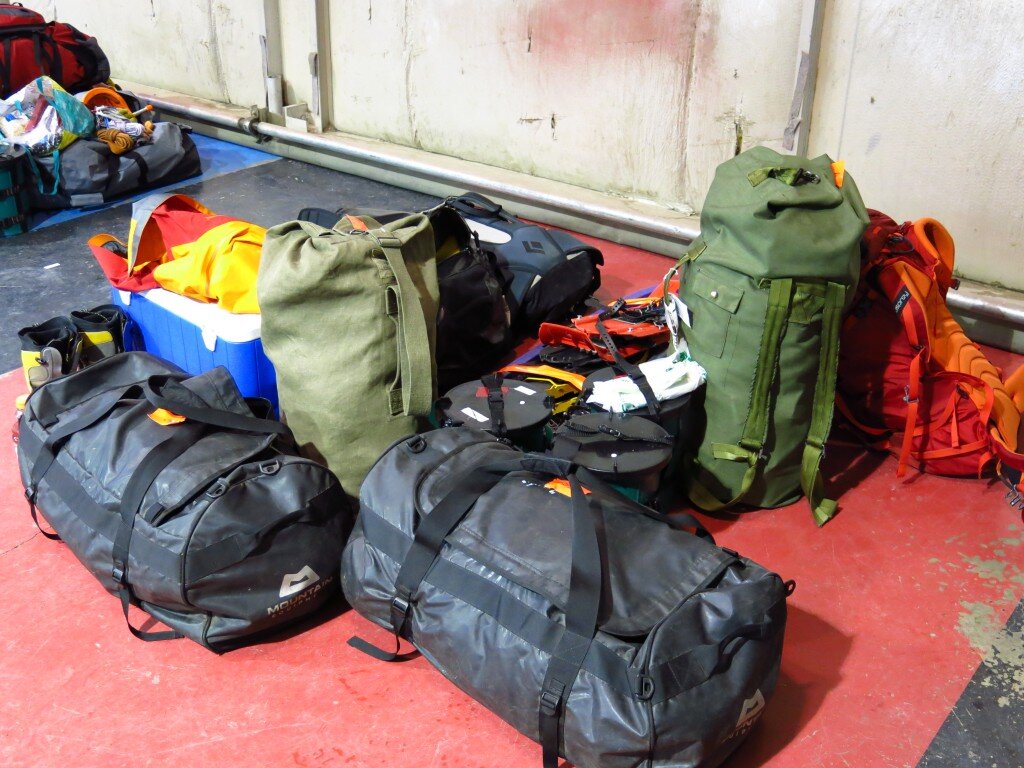There's something about Alaska...
There’s something special, something truly wondrous about Alaska. It’s been said so many times, it would be easy to dismiss praise for The Last Frontier. Especially since I’ve spent the last five or so years exploring some of the world’s great ranges, I didn’t expect to be so taken aback by this place. But the ruggedness, scale, and limitless light and freedom in the heart of the Alaska Range are unparalleled. Everything in Alaska is big: From raging, mile-wide rivers like the Susitna, to the linear post-glacial features that stretch hundreds of miles from the Pacific Ocean to Denali, The Great One, to Talkeetna’s blood-guzzling mosquitoes. Even “Little Switzerland,” our destination for a week of spectacular alpine rock climbing, was a grand adventure. After waiting out a bit of rain in Talkeetna, Brad and I flew up to the Pika Glacier in a single engine plane with one of Alaska's legendary bush pilots. These workhorse DeHavillands and Cessnas from the World War II era are truly marvels of engineering.
After waiting out a bit of rain in Talkeetna, Brad and I flew up to the Pika Glacier in a single engine plane with one of Alaska's legendary bush pilots. These workhorse DeHavillands and Cessnas from the World War II era are truly marvels of engineering. Landing a plane on a glacier with skis is a pretty mind-boggling and abrupt way to enter the alpine. But aside from the tourist visits by bush plane, Brad and I had a week to ourselves in spectacular wilderness.
Landing a plane on a glacier with skis is a pretty mind-boggling and abrupt way to enter the alpine. But aside from the tourist visits by bush plane, Brad and I had a week to ourselves in spectacular wilderness. Our first day on the glacier consisted of digging tent platforms and getting a bit set up and dug into the glacier. As we had clear blue skies and 24 hour daylight at our disposal, we quickly made a late lunch and roped up for our first climb, an ascent of the nearby Middle Troll. Upon arriving at the summit after hours of exploratory climbing on sometimes clean, sometimes loose and chossy Alaskan granite, we arrived at the tiny perch of the summit and 360 degree views of Denali, Foraker, Hunter and other Alaska Range giants. In no rush to get down, we soaked in the evening sunshine before returning to camp.
Our first day on the glacier consisted of digging tent platforms and getting a bit set up and dug into the glacier. As we had clear blue skies and 24 hour daylight at our disposal, we quickly made a late lunch and roped up for our first climb, an ascent of the nearby Middle Troll. Upon arriving at the summit after hours of exploratory climbing on sometimes clean, sometimes loose and chossy Alaskan granite, we arrived at the tiny perch of the summit and 360 degree views of Denali, Foraker, Hunter and other Alaska Range giants. In no rush to get down, we soaked in the evening sunshine before returning to camp. Our second day was a gut check. These are some of the northernmost big mountains in the world, and we spent all day digging in, and averting one mini-disaster after another as we were pummeled by rain and hail. We made the necessary improvements quickly, however and soon had a luxurious living room/kitchen dug in and complete with custom furniture carved from the glacial snowpack.
Our second day was a gut check. These are some of the northernmost big mountains in the world, and we spent all day digging in, and averting one mini-disaster after another as we were pummeled by rain and hail. We made the necessary improvements quickly, however and soon had a luxurious living room/kitchen dug in and complete with custom furniture carved from the glacial snowpack. Thereafter, as skies cleared, we settled into a comfortable rhythm, waking up late in the morning to dry our boots, clothes and ropes, finally emerging from our tents groggily in the mid-afternoon and climbing late into the night.
Thereafter, as skies cleared, we settled into a comfortable rhythm, waking up late in the morning to dry our boots, clothes and ropes, finally emerging from our tents groggily in the mid-afternoon and climbing late into the night. The Pika was good to us and after a few more gorgeous climbs, we took the hint and called for a bush plane pickup before the weather soured. On the way out, as Brad in particular aspires to climb historic hard-man routes in the Alaska Range, and I am an aviation nerd at heart, we opted for some extra airtime on the way out. Again, a masterful pilot from K2 aviation danced us in and out of alpine cirques and down deep granite gorges. These guys have the best job in the world and they know it. Thanks Alaska for the warm and sunny welcome!
The Pika was good to us and after a few more gorgeous climbs, we took the hint and called for a bush plane pickup before the weather soured. On the way out, as Brad in particular aspires to climb historic hard-man routes in the Alaska Range, and I am an aviation nerd at heart, we opted for some extra airtime on the way out. Again, a masterful pilot from K2 aviation danced us in and out of alpine cirques and down deep granite gorges. These guys have the best job in the world and they know it. Thanks Alaska for the warm and sunny welcome!




Guest Post: Brad's Pika Glacier Trip Report!
Obligatory editor's note: Brad and I have returned from the Pika Glacier and "Little Switzerland" and are now in Anchorage awaiting flights back to CA. We had an incredible time and I have much more on the way. In the mean time, here's Brad's excellent trip report, written in part for the American Alpine Club's Live Your Dream Grant which partially supported his trip. You may remember I received this same form of generous AAC funding for my Snow Leopard Peaks of the Pamir expedition in 2012. Here's Brad...The purpose of this trip, for me, was to break into technical climbing in the Alaska Range. The Pika Glacier seemed like the perfect place to do this. I could use this trip to learn about the weather patterns in the Range, figure out trip logistics, and grow my geographical knowledge. My thinking was: "With moderate routes and simple logistics, this should be easy, right?"
There were some complications. Unseasonable snowfall had just dropped 36” of new snow as we flew into the Pika glacier on June 28, 2014. On board was Chris from K2 Aviation, myself (Brad), Hari, and our stuffed Pika mascot named Jackson. As we flew in we saw avalanches everywhere. Warm temperatures after the storms cleared had resulted in alarming avy conditions. We would later watch as an entire snow field slid, at once, over an established route on the East Face of the Throne. “What are we doing out here?” I asked myself.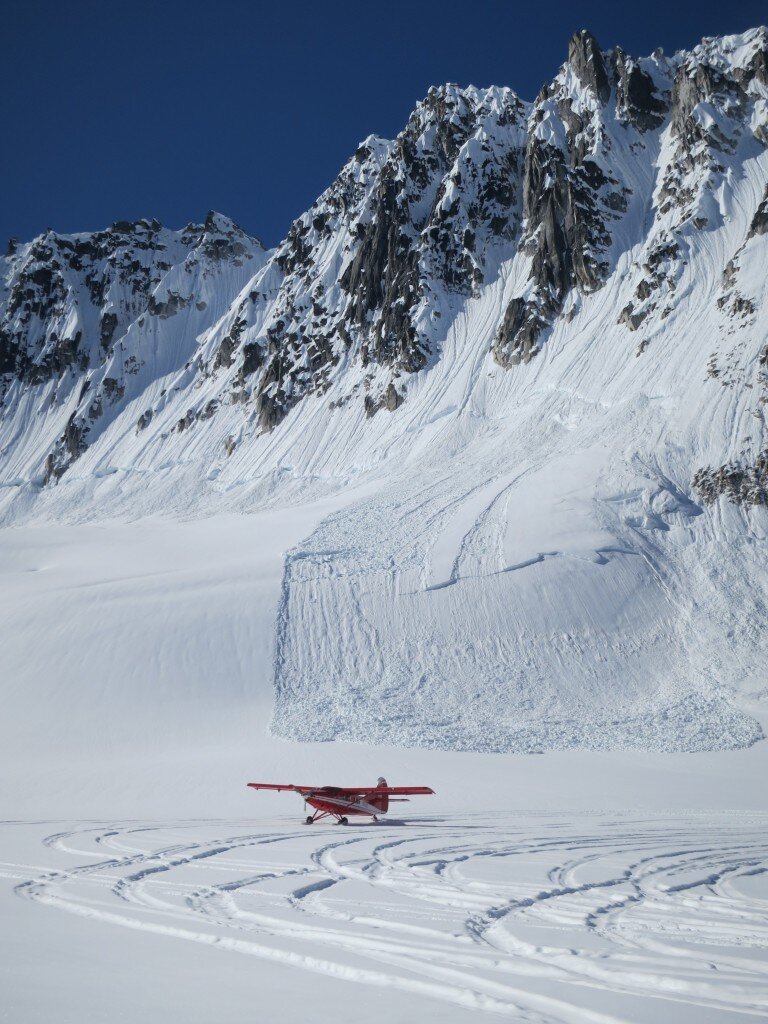 As our plane flew overhead, we felt the “Alaska Factor.” “What is our safety net out here?” I wondered. We had a satellite phone for emergencies, but evacuations are only possible in good weather. To thrive in this setting requires competence, self reliance, and hard work. Although I’ve visited the Alaska Range several times, I still feel drawn to the wildness of the place, and everything it entails.
As our plane flew overhead, we felt the “Alaska Factor.” “What is our safety net out here?” I wondered. We had a satellite phone for emergencies, but evacuations are only possible in good weather. To thrive in this setting requires competence, self reliance, and hard work. Although I’ve visited the Alaska Range several times, I still feel drawn to the wildness of the place, and everything it entails.
We made camp and discussed our options. 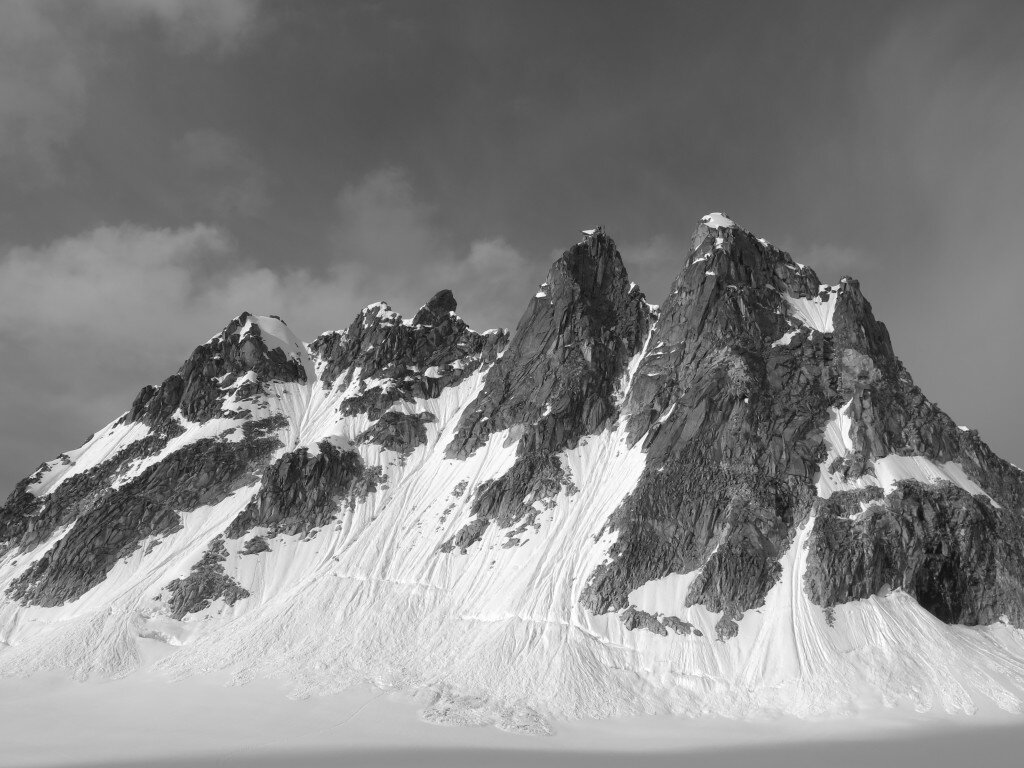 We decided to proceed with caution up the South Face of Middle Troll. We climbed a variation to the standard route with two deviations: a fun 5.9 dihedral above the bergschrund and a great 5.7 chimney below the summit block. Getting over the bergschrund consisted of an 1m wide crevasse on a ~60 degree slope of mushy snow. When prodded, the slope would set loose an avalanche that would tumble into the pit, taking any foolish climbers along with it. We finally made it over using a technique that felt like swimming but looked much goofier.
We decided to proceed with caution up the South Face of Middle Troll. We climbed a variation to the standard route with two deviations: a fun 5.9 dihedral above the bergschrund and a great 5.7 chimney below the summit block. Getting over the bergschrund consisted of an 1m wide crevasse on a ~60 degree slope of mushy snow. When prodded, the slope would set loose an avalanche that would tumble into the pit, taking any foolish climbers along with it. We finally made it over using a technique that felt like swimming but looked much goofier.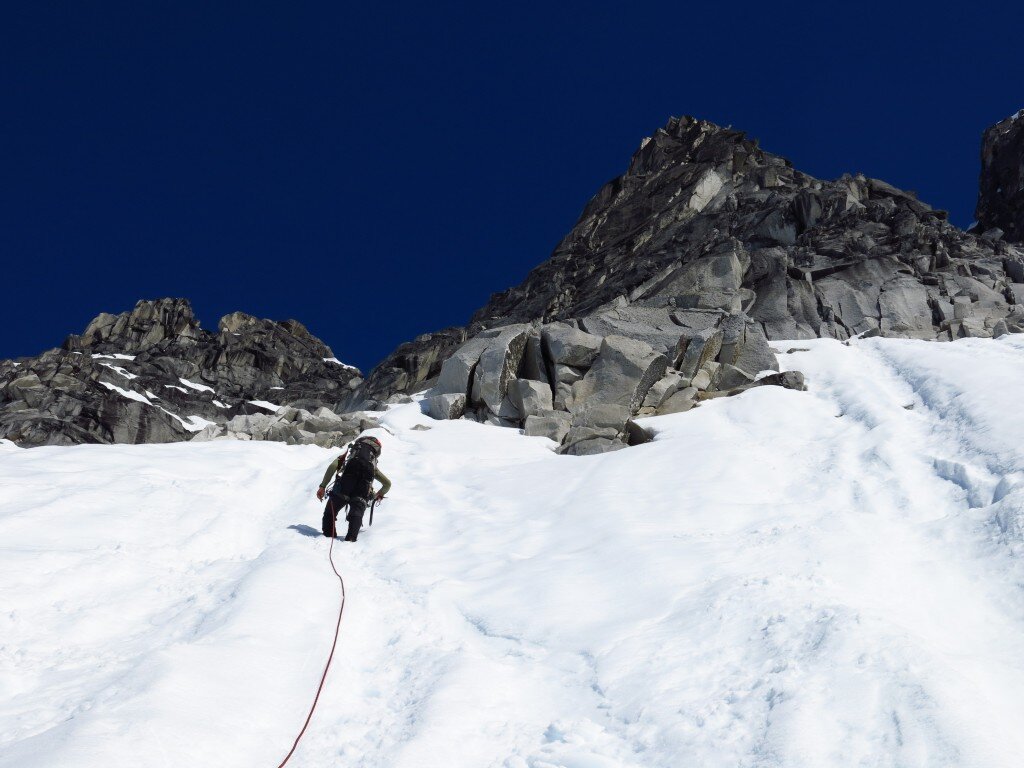 On the summit, we sat back and enjoyed the views of the big mountains. With 24 hours of sunlight, we were in no hurry to start our descent.
On the summit, we sat back and enjoyed the views of the big mountains. With 24 hours of sunlight, we were in no hurry to start our descent.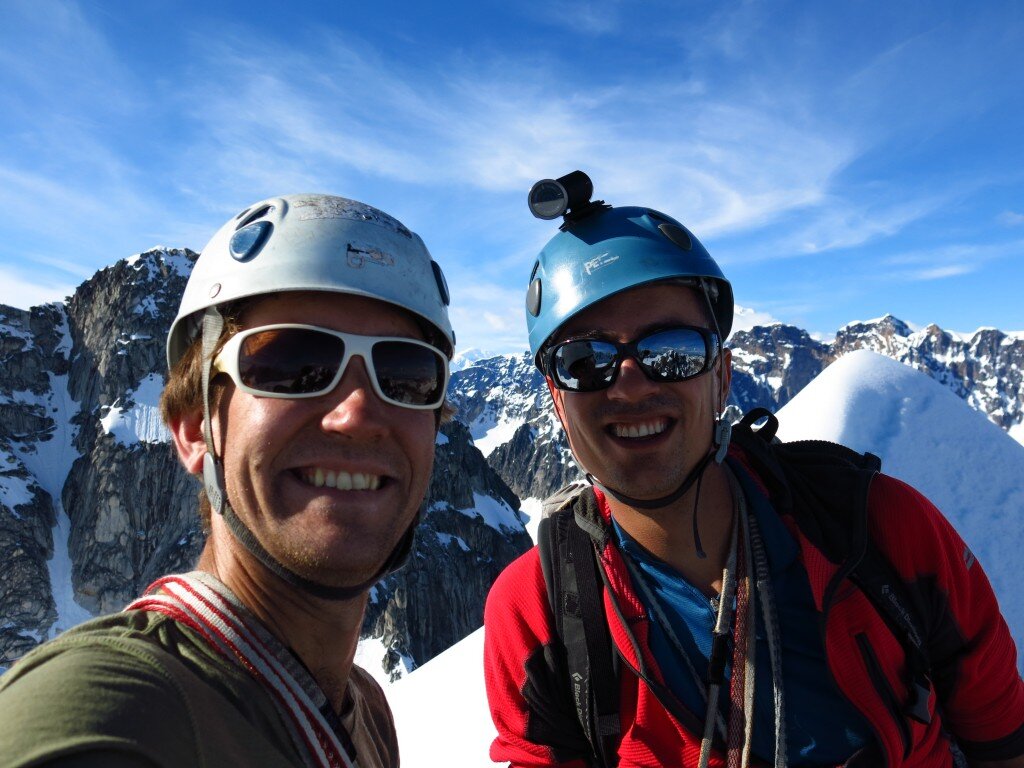 On the Troll we noticed a troubling pattern: TONS unnecessary amount of rappel stations. Although the Troll could be rappelled using only four stations with two 60m ropes, we found dozens of rappel stations. Some of the stations were even located horizontally next to each other. On this trip we removed over 50m of old rappel station garbage.
On the Troll we noticed a troubling pattern: TONS unnecessary amount of rappel stations. Although the Troll could be rappelled using only four stations with two 60m ropes, we found dozens of rappel stations. Some of the stations were even located horizontally next to each other. On this trip we removed over 50m of old rappel station garbage.
What's going on with all the trash rap stations? Is it because an ethic of under-reporting means that people don't know about the presence of good stations? Or maybe it's just because lots of noobs (like me) go to Little Switzerland? Would it help if the Park allowed hand drilled bolts? I'm not sure what the solution is.
Anyways, on Sunday we were tent-bound in a rain storm. This was the low point of the trip, but fortunately it would turn out to be our only bad-weather day of the entire expedition. One of our single-walled tent flooded. During breaks in the storm we would get out and fortify our camp.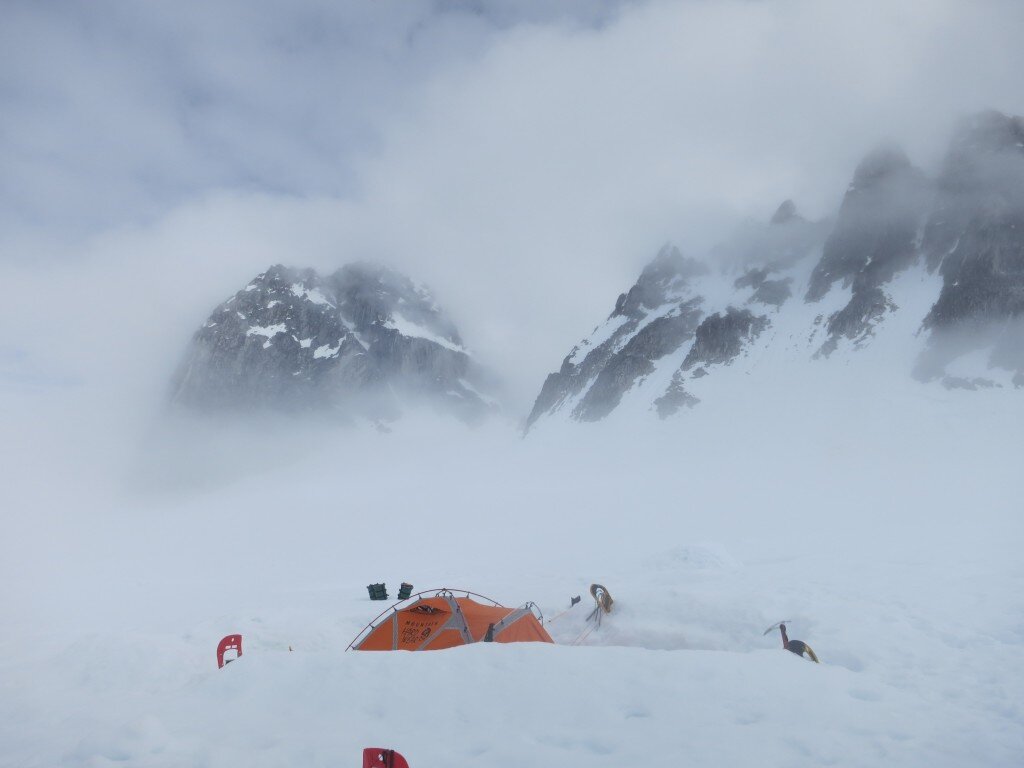 On Monday the weather cleared as a beautiful weather system moved in. We climbed the Munchkin. This was a nice, short, and easy climb with an incredible topout. We didn’t get the summit because we were lazy and didn’t want to traverse a sketchy looking snow field.
On Monday the weather cleared as a beautiful weather system moved in. We climbed the Munchkin. This was a nice, short, and easy climb with an incredible topout. We didn’t get the summit because we were lazy and didn’t want to traverse a sketchy looking snow field. 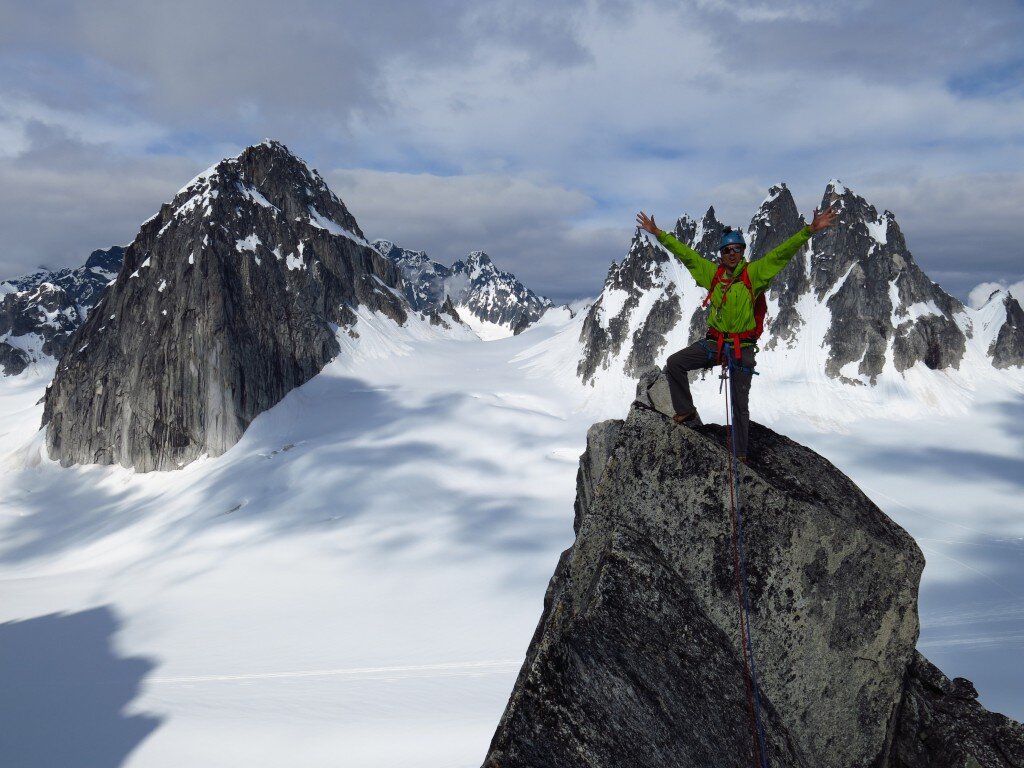 There was also a fun knife-edge ridge.Starting on this day of good weather, we also realized how busy our airstrip would be. The Pika Glacier is a preferred spot for pilots to take tourists. They generally land, walk around for 10-20 minutes, and then fly away.
There was also a fun knife-edge ridge.Starting on this day of good weather, we also realized how busy our airstrip would be. The Pika Glacier is a preferred spot for pilots to take tourists. They generally land, walk around for 10-20 minutes, and then fly away.
The de Havilland Beaver is the iconic Alaska bush plane. You can put floats on it to land on water or skis to land on snow. It’s the little brother of the de Havilland Otter but larger than the Cessna 185. It’s also incredibly loud. Loud like when you cover your ears you can feel your chest vibrate. I’m surprised that they allow these things in the Park. Doesn't this noise bother wildlife?
I'll focus on the climbing now and stop complaining...
On Tuesday we hiked over to the base of the Gargoyle Buttress but decided not to climb it because of the snow conditions. Not only was the base of this route being showered by avalanches almost constantly, but most of the low fifth class (easy) pitches were covered in loose, unconsolidated snow.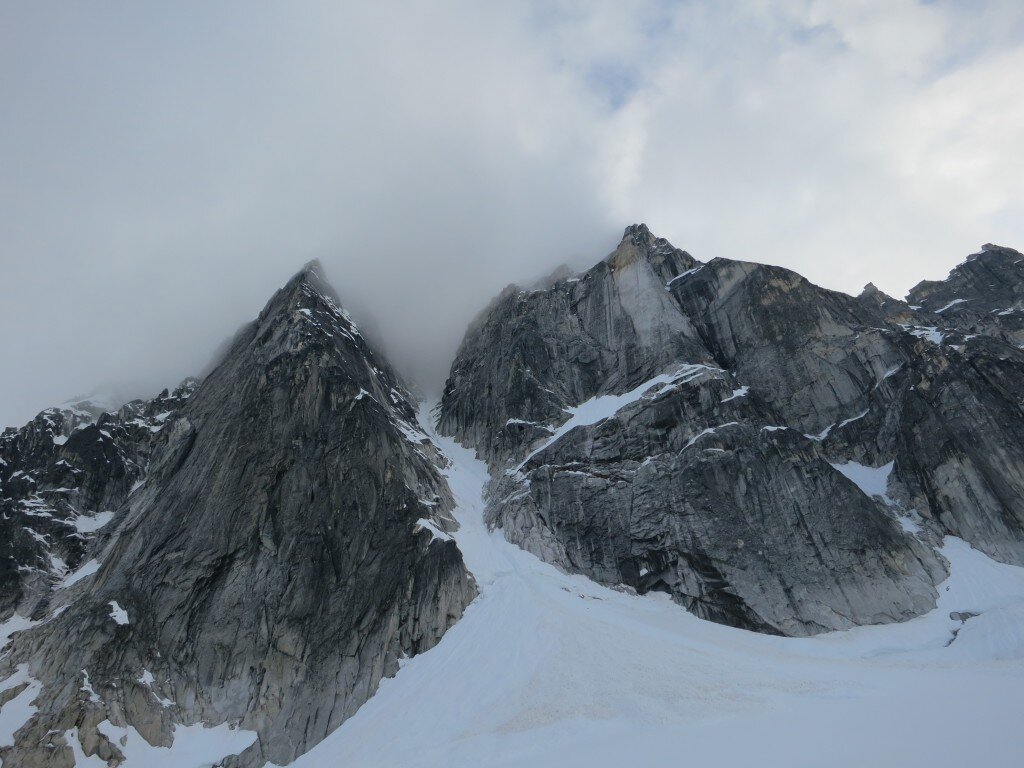 On Wednesday we climbed the Hobbit’s Footstool by a nice, clean rock route up the South (climbers’ right) ridge.
On Wednesday we climbed the Hobbit’s Footstool by a nice, clean rock route up the South (climbers’ right) ridge.
We took full advantage of the 24 hours of Alaskan sunlight and gradually became nocturnal over the trip. The main reason for this was to avoid the sweltering temperatures on the glacier during the day. There were also fewer avalanches and tourist planes at night. By our last climbs, we were returning to camp at 2am. This also had the nice benefit of warm temperatures while sleeping and the ability to dry our boots over breakfast (at 2 pm).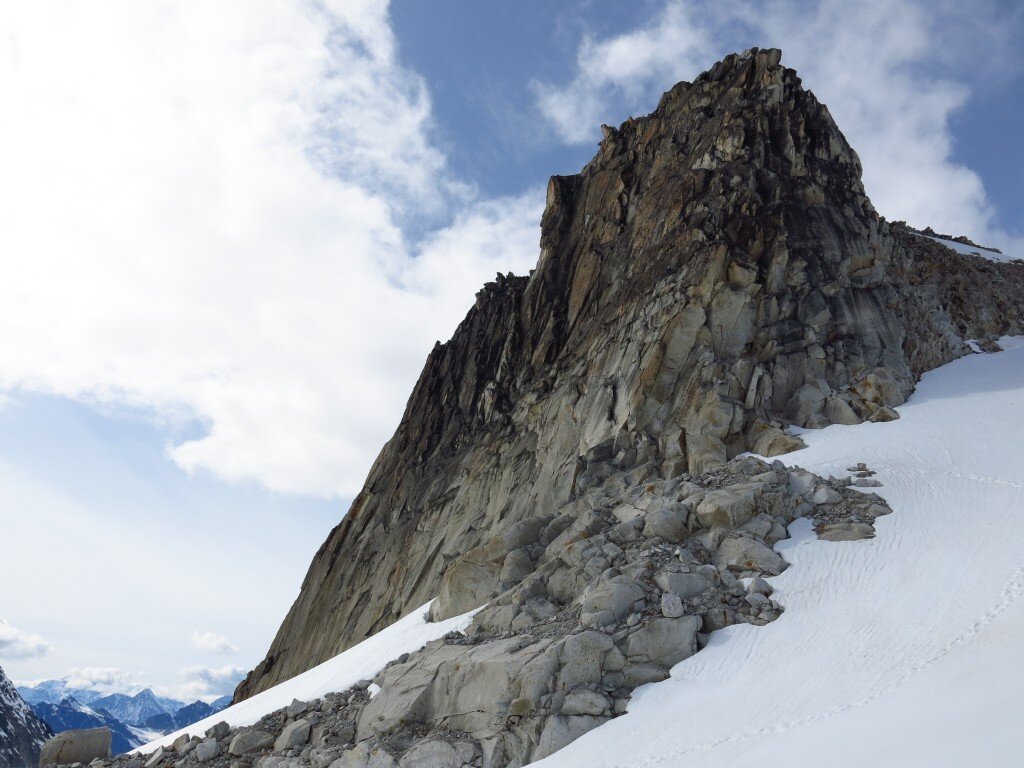 On Thursday we climbed the Lost Marsupial route on the Throne. This route involved high quality granite crack systems with some wandering third class terrain. Some lower angle terrain was snowy. Our upward progress was halted at the summit ridge by enormous cornices.
On Thursday we climbed the Lost Marsupial route on the Throne. This route involved high quality granite crack systems with some wandering third class terrain. Some lower angle terrain was snowy. Our upward progress was halted at the summit ridge by enormous cornices.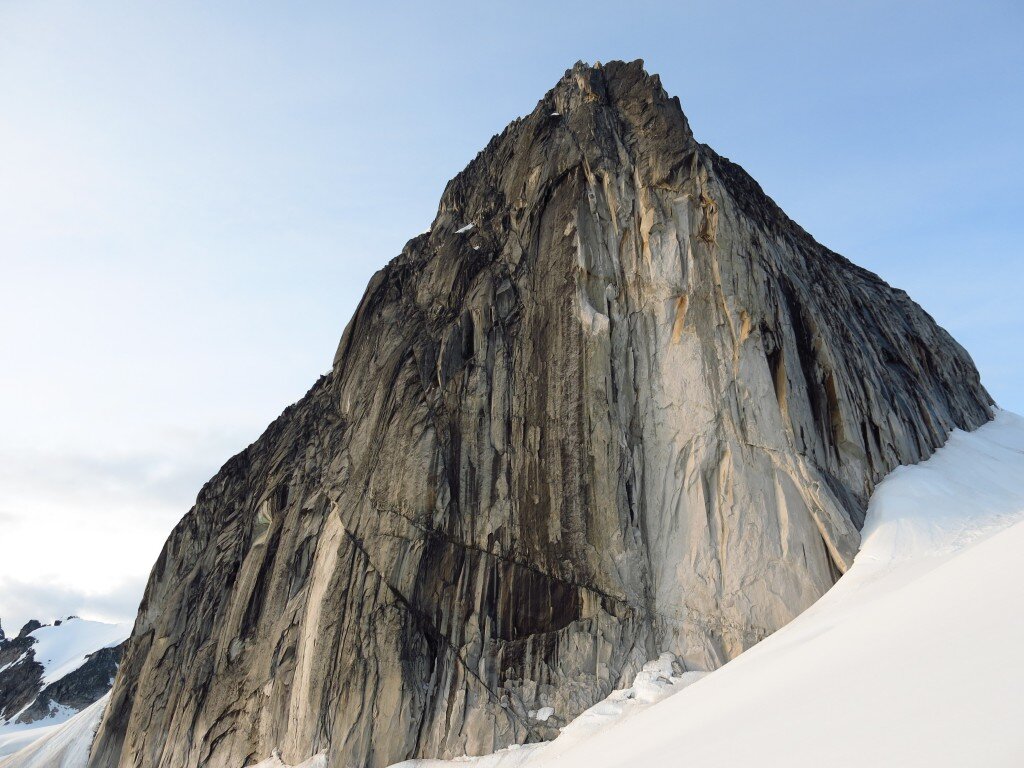
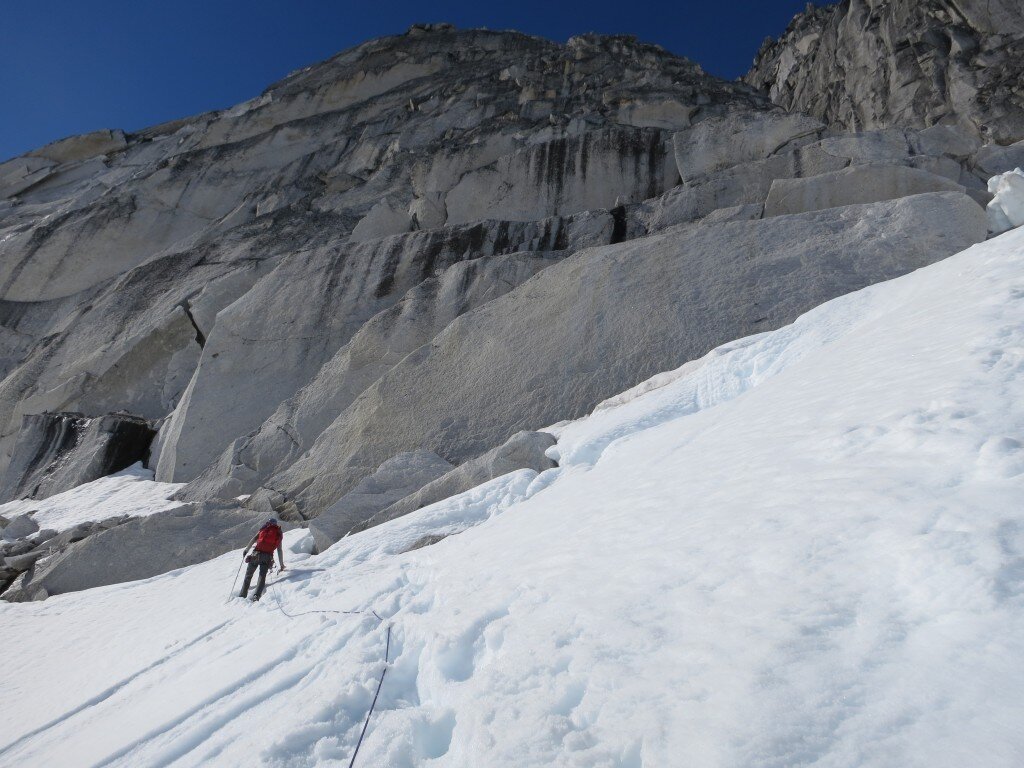
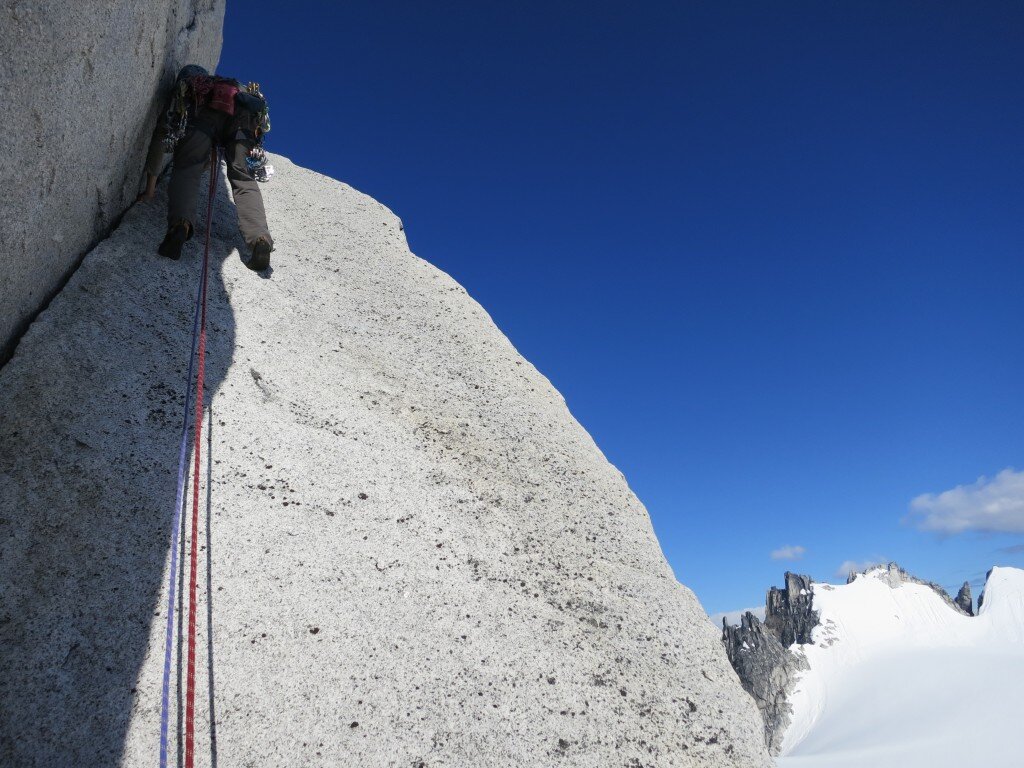 On Friday we packed up camp and flew back to Talkeetna. We took extra flight time to look at the classics of the Range: the Cassin Ridge, the Infinite Spur, the Moonflower Buttress, and Ham and Eggs.
On Friday we packed up camp and flew back to Talkeetna. We took extra flight time to look at the classics of the Range: the Cassin Ridge, the Infinite Spur, the Moonflower Buttress, and Ham and Eggs.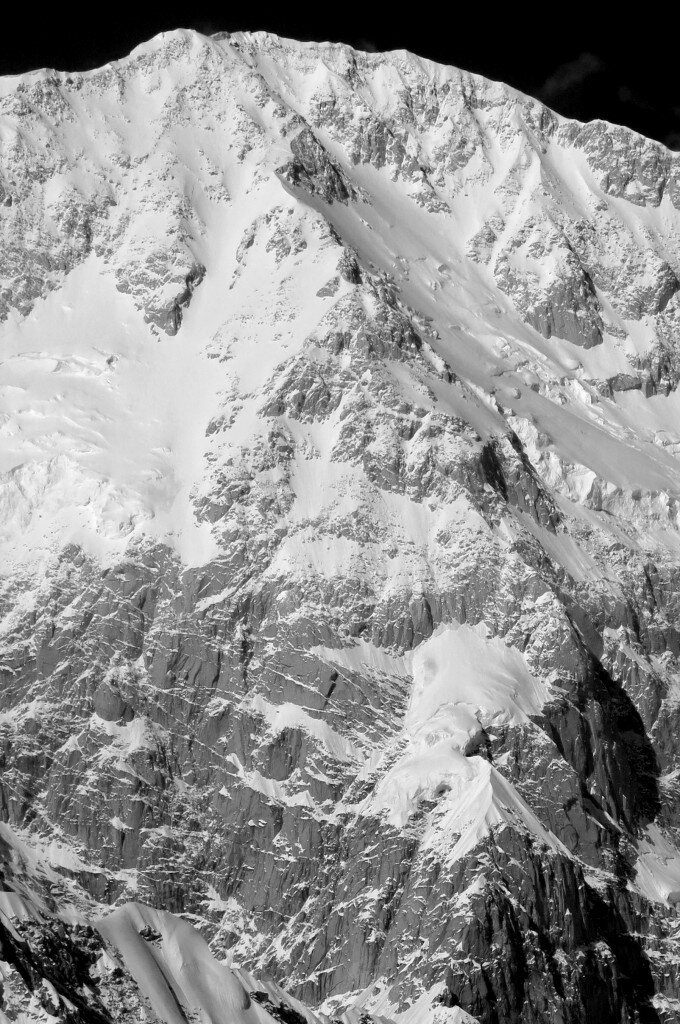 Our original flight out was scheduled for Sunday but we decided to head back early for a variety of reasons. It turns out that a weather system moved into the region on Sunday, so it was good luck that we decided to head out when we did.
Our original flight out was scheduled for Sunday but we decided to head back early for a variety of reasons. It turns out that a weather system moved into the region on Sunday, so it was good luck that we decided to head out when we did.
Talkeetna
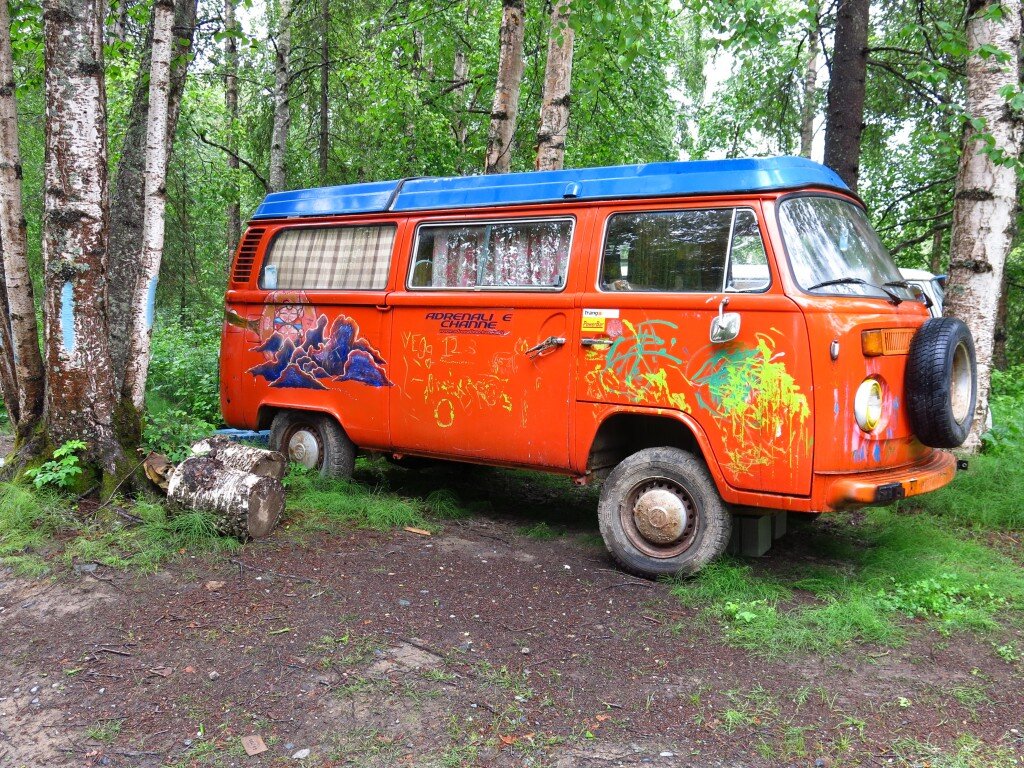 The marquee event of my summer is underway. Brad and I are in tiny (and currently rainy) Talkeetna, Alaska staging for a trip to the Pika Glacier in Denali National Park. We're hunkered down waiting out a historic storm (three feet of fresh snow fell yesterday at Denali base camp) for our bush plane flight onto the glacier. Fingers crossed, we should have a week and a half (completely to ourselves!!) in magnificent surroundings. We've been spending our time hanging out with the locals (population ~800ish, approximately 600 of whom live in the woods in homes accessible only by foot, boat, 4-wheeler or snow machine), chilling in a plane hangar with a guided Denali party, and strolling around town. More news in a bit!
The marquee event of my summer is underway. Brad and I are in tiny (and currently rainy) Talkeetna, Alaska staging for a trip to the Pika Glacier in Denali National Park. We're hunkered down waiting out a historic storm (three feet of fresh snow fell yesterday at Denali base camp) for our bush plane flight onto the glacier. Fingers crossed, we should have a week and a half (completely to ourselves!!) in magnificent surroundings. We've been spending our time hanging out with the locals (population ~800ish, approximately 600 of whom live in the woods in homes accessible only by foot, boat, 4-wheeler or snow machine), chilling in a plane hangar with a guided Denali party, and strolling around town. More news in a bit!